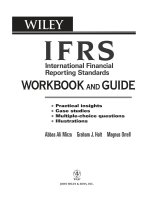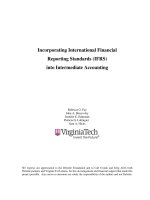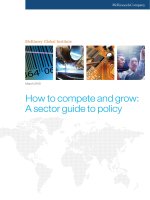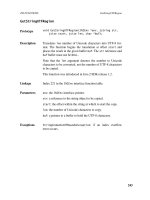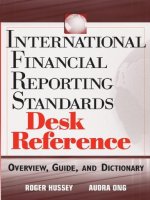INTERNATIONAL FINANCIAL REPORTING STANDARDS DESK REFERENCE Overview, Guide, and Dictionary phần 1 doc
Bạn đang xem bản rút gọn của tài liệu. Xem và tải ngay bản đầy đủ của tài liệu tại đây (220.62 KB, 40 trang )
INTERNATIONAL
FINANCIAL
REPORTING
STANDARDS DESK
REFERENCE
Overview, Guide,
and Dictionary
Dr. Roger Hussey
Dr. Audra Ong
John Wiley & Sons, Inc.
ffirs.qxd 3/3/05 1:00 PM Page iii
ffirs.qxd 3/3/05 1:00 PM Page ii
INTERNATIONAL
FINANCIAL
REPORTING
STANDARDS DESK
REFERENCE
ffirs.qxd 3/3/05 1:00 PM Page i
ffirs.qxd 3/3/05 1:00 PM Page ii
INTERNATIONAL
FINANCIAL
REPORTING
STANDARDS DESK
REFERENCE
Overview, Guide,
and Dictionary
Dr. Roger Hussey
Dr. Audra Ong
John Wiley & Sons, Inc.
ffirs.qxd 3/3/05 1:00 PM Page iii
This book is printed on acid-free paper.
Copyright © 2005 by John Wiley & Sons, Inc. All rights reserved.
Published by John Wiley & Sons, Inc., Hoboken, New Jersey
Published simultaneously in Canada
No part of this publication may be reproduced, stored in a retrieval system, or transmitted in
any form or by any means, electronic, mechanical, photocopying, recording, scanning, or
otherwise, except as permitted under Section 107 or 108 of the 1976 United States Copyright
Act, without either the prior written permission of the Publisher, or authorization through
payment of the appropriate per-copy fee to the Copyright Clearance Center, Inc., 222 Rosewood
Drive, Danvers, MA 01923, 978-750-8400, fax 978-646-8600, or on the web at
www.copyright.com. Requests to the Publisher for permission should be addressed to the
Permissions Department, John Wiley & Sons, Inc., 111 River Street, Hoboken, NJ 07030,
201-748-6011, fax 201-748-6008, or online at />Limit of Liability/Disclaimer of Warranty: While the publisher and author have used their best
efforts in preparing this book, they make no representations or warranties with respect to the
accuracy or completeness of the contents of this book and specifically disclaim any implied
warranties of merchantability or fitness for a particular purpose. No warranty may be created or
extended by sales representatives or written sales materials. The advice and strategies contained
herein may not be suitable for your situation. You should consult with a professional where
appropriate. Neither the publisher nor author shall be liable for any loss of profit or any other
commercial damages, including but not limited to special, incidental, consequential, or other
damages.
For general information on our other products and services, or technical support, please contact
our Customer Care Department within the United States at 800-762-2974, outside the United
States at 317-572-3993 or fax 317-572-4002.
Wiley also publishes its books in a variety of electronic formats. Some content that appears in
print may not be available in electronic books.
Library of Congress Cataloging-in-Publication Data:
ISBN-13 978-0-471-71450-X
ISBN-10 0-471-71450-X
Printed in the United States of America
10987654321
ffirs.qxd 3/3/05 1:00 PM Page iv
Contents
v
FOREWORD vii
PREFACE ix
ACKNOWLEDGMENTS xi
Part One
OVERVIEW: STANDARD SETTING
NATIONALLY AND GLOBALLY
CHAPTER 1 The Growth of National Standards 3
Early Developments 3
The Advent of Regulation 5
CHAPTER 2 Developing International Accounting Standards 8
The Emergence of National Similarities 8
The Impetus for Global Standards 10
The International Accounting Standards Committee 11
CHAPTER 3 The International Accounting Standards Board 15
Formation of the IASB 15
Structure of the IASB 17
Funding and Operation of the IASB 18
Enforcement 20
The Path to Convergence 21
ftoc.qxd 3/3/05 1:01 PM Page v
CHAPTER 4 Internationalization and the G4+1 Countries 23
Introduction 23
Australia and New Zealand 24
Canada 26
United Kingdom 27
United States 30
CHAPTER 5 Different Views of Convergence 33
Introduction 33
Japan 34
Malaysia 35
People’s Republic of China 36
Taiwan, Republic of China 37
Islamic Finance and Standard Setting 38
CHAPTER 6 Responding to Internationalization 41
Progress and Problems 41
Effects and Action 43
CHAPTER 7 The Role of the Accountant 49
The Ripple Effect 49
The Main Changes 50
The Link with Corporate Governance 51
Final Check 53
Bibliography 54
Part Two
GUIDE TO INTERNATIONAL FINANCIAL
REPORTING STANDARDS
Introduction to the Guide 59
Framework for the Preparation and Presentation
of Financial Statements 65
Summary of Individual Standards 71
Part Three
DICTIONARY
How to Use the Dictionary 181
Dictionary 183
APPENDIX A List of Acronyms 359
APPENDIX B Accounting Standard Setting Bodies 367
INDEX 377
vi • Contents
ftoc.qxd 3/3/05 1:01 PM Page vi
Foreword
vii
The effort to achieve a single set of global accounting standards has gained
significant momentum during the past three years. The logic behind the devel-
opment of a single set of high-quality global accounting standards for the
world’s integrating capital markets has been evident for some time. The col-
lapse of Enron and other corporate failures in the United States and elsewhere
have led to the reevaluation of existing national and international accounting
practices and has served as a catalyst for work being undertaken at the Inter-
national Accounting Standards Board (IASB) in conjunction with national
standard setters throughout the world.
Increasingly, in recognition of the integrating nature of the world’s capital
markets, national authorities are opting for an international approach to ac-
counting standards. In 2005, some 92 countries throughout the world will re-
quire or permit the use of international financial reporting standards (IFRSs),
as promulgated by the IASB.
Nowhere is the embrace of high-quality accounting standards possibly
more significant than in Europe and Asia. Most countries, however, are begin-
ning to experience the influence of IFRSs in their everyday business.
In Europe, a single economic market would be impossible to operate with
25 countries using 26 different methods of accounting as at present. (Only
Ireland and the United Kingdom use the same accounting methods, and some
countries allow either or both U.S. GAAP and international standards.)
The Asian financial crisis of the 1990s demonstrated the central role that
accounting plays in globalizing capital markets and the potential devastating
fbetw.qxd 3/3/05 1:01 PM Page vii
effects that diminished confidence in financial reporting could have in slowing
economic development. The stakes of adopting a strong financial reporting
infrastructure are great for emerging economies, because these economies
cannot reach their full potential without participation in global markets and
without continuing inflows of direct investment.
Reaching the ultimate goal of having a single set of accounting standards
worldwide, however, still faces significant barriers. These include a full under-
standing of the terms used in their particular context and the differences in
language. These are problems that the authors of this volume, Dr. Roger
Hussey and Dr. Audra Ong, understand well. The IASB, located in London,
sets its standards in English and considers the English language standards the
official set. It is evident that jurisdictions throughout the world may wish to
apply the standards translated in their own language. Without quality in
translation, we will risk losing consistency in application of the standards.
The IASB has worked to expand its translation resources to improve the qual-
ity of the standards provided in other languages, but there is always more
work to be done.
Therefore, I welcome this important contribution from Dr. Hussey and Dr.
Ong. This volume marks a significant step forward to improving access to in-
ternational standards for those whose native language is not English and for
English speakers. This book is written by authors who clearly understand the
challenges facing all who seek to understand and apply international stan-
dards. I commend it to you.
Sir David Tweedie
Chair of the International
Accounting Standards Board
London, United Kingdom
December 2004
viii • Foreword
fbetw.qxd 3/3/05 1:01 PM Page viii
Preface
ix
The world of accounting and finance has been going through monumental
changes in recent years. At the international level, there have been intense ef-
forts to establish credible and transparent methods for measuring and com-
municating business financial results. Key factors contributing to increased
scrutiny on accounting are the high-profile financial frauds and scandals that
received so much media attention. Another key factor is that the increasing
complexities of business in today’s high-tech, global economy require new ac-
counting approaches.
More and more companies today are doing business on an international
scale, creating a need for accountants, executives, and organizations in differ-
ent countries to reach agreement on accounting rules and standards. The ac-
counting profession has responded by establishing international accounting
and financial reporting standards, and substantial progress has been made to-
ward international acceptance of these standards.
If you are a practitioner, manager, or student, or are involved in business in
any way, this book will be invaluable. It provides an overview of the Interna-
tional Accounting Standards Board, including a guide to the standards issued
as well as a comprehensive dictionary of key international accounting, report-
ing, and finance terms.
This book consists of three parts and two appendices. The first Part describes
the growth of national accounting standards setting, the events leading to the de-
sire for international accounting standards, and the organizational structure,
funding, and operation of the IASB. It concludes with an examination of the
fpref.qxd 3/3/05 1:01 PM Page ix
changes that must be implemented by organizations and countries adopting in-
ternational accounting standards and the implications for education and train-
ing, professional accounting bodies, regulators, and organizations.
The second Part, the Guide, describes the scope and main requirements of
each current standard. International Financial Reporting Standards (IFRSs)
are lengthy and complex. The Guide captures succinctly the key points of
each standard.
The third section, the Dictionary, is a comprehensive reference to words
and phrases used in the global business world. Definitions are included for
specific terms used in the international standards and are cross-referenced to
the particular standard. Appendix A consists of a list of acronyms that relate
to the various terms and definitions used in the Overview, Guide, and Dictio-
nary. In addition, a directory of national standard setters is provided as a ref-
erence in Appendix B.
It would be imprudent for any authors, particularly compilers of an inter-
national guide and dictionary, to claim that their work is the final word on a
subject. The business world is complex and constantly changing, and IFRSs
will be modified or developed in response to these changes. This Desk Refer-
ence is intended to provide a background on how the movement toward a
common language for international accounting evolved to its present state,
summarize existing standards highlighting the key issues covered, and capture
those terms and phrases that are fundamental to an understanding of the
common language of global business. We believe that readers will find this
book an invaluable reference in helping their comprehension of this language.
Roger Hussey
Audra Ong
Canada
January 2005
x • Preface
fpref.qxd 3/3/05 1:01 PM Page x
Acknowledgments
xi
We wish to acknowledge the advice and comment we received from col-
leagues around the world. In particular, the following were most helpful in
giving perceptive opinions on Part One of the book.
Roger Adams, FCCA, Technical Executive Director, Association of
Chartered Certified Accountants (ACCA), United Kingdom
Sally Aisbitt, Ph.D., Open University Business School, England
Russell Craig, Ph.D., Australian National University, Australia
Istemi Demirag, Ph.D., Queen’s University, Northern Ireland
Rob Gray, Ph.D., St. Andrew’s University, Scotland
John Haverty, Ph.D., Saint Joseph’s University, Philadelphia, United States
Wan Nordin Wan Hussin, Ph.D., University Utara, Malaysia
Finally, we would like to thank Andrea Steele from the Faculty of Arts and
Social Sciences and Michelle Doerksen, Bree-Anne LaBute, and Alison
Scratch from the Odette School of Business at the University of Windsor for
their tireless efforts in preparing the manuscript for publication against tight
timelines.
As always, the authors take full responsibility for any errors and omissions.
flast.qxd 3/3/05 1:02 PM Page xi
flast.qxd 3/3/05 1:02 PM Page xii
INTERNATIONAL
FINANCIAL
REPORTING
STANDARDS DESK
REFERENCE
flast.qxd 3/3/05 1:02 PM Page xiii
flast.qxd 3/3/05 1:02 PM Page xiv
Part One
OVERVIEW:
STANDARD SETTING
NATIONALLY
AND GLOBALLY
“Our methods of measurement define who we are
and what we value.”
Ken Alder, The Measure of All Things.
The Free Press, 2002, page 2.
ccc_hussey_pt1_1-2.qxd 2/16/05 12:27 PM Page 1
ccc_hussey_pt1_1-2.qxd 2/16/05 12:27 PM Page 2
CHAPTER 1
The Growth of
National Standards
3
EARLY DEVELOPMENTS
National procedures, organizations, and regulations for accounting are cur-
rently at a watershed, due to the increasing influence of the International Ac-
counting Standards Board (IASB). Effective April 1, 2001, the IASB had
assumed standard setting responsibilities from its predecessor body, the Inter-
national Accounting Standards Committee (IASC).
The national standard setting bodies are also at various stages in their re-
sponse and strategies. A number of major players, for example the European
Union, China, and Australia have adopted, or will soon be adopting, Interna-
tional Financial Reporting Standards (IFRSs) for some or all entities. The U.S.
Financial Accounting Standards Board (FASB), through the Norwalk Agree-
ment, and the IASB have given a formal commitment to convergence. More
on this is discussed in Chapter 4. Other countries have also declared an inten-
tion to converge their standards with international pronouncements, and
some still have not decided on their course of action.
Smaller nations generally have not had the resources and infrastructure to
generate their own standards, and have either adopted or modeled their regu-
lations on the standards of the United Kingdom or the United States. With the
formation of the IASB, several countries chose to adopt international ac-
counting standards. This was particularly true for emerging economies, where
the flexibility of the standards made them easier to implement and where
ccc_hussey_ch1_3-7.qxd 2/16/05 12:27 PM Page 3
there was a concern that adopting the standards of one particular country
would have political connotations.
Although there is some public debate concerning the number of countries
that will adopt IFRSs, very few countries or organizations will remain com-
pletely unaffected by the influence of international harmonization. Business is
becoming increasingly global, and accounting is changing rapidly to meet the
demands placed upon it. Words and phrases originally used in one country
have gained acceptance in others. Pronouncements made by the IASB have
found their way, either in part or whole, into accounting practices. Anyone
involved in business needs to understand the events that are taking place and
how businesses are affected by them.
What is surprising, given the long history of accounting, is that these in-
ternational events only commenced 30 years ago, with progress accelerat-
ing over the last few years. The following brief examination of the very
slow development of accounting will help explain the changes that are now
taking place.
Since the earliest times, individuals, societies, and civilizations have all ex-
perienced the need for some form of record keeping of events, transactions,
and other phenomena. Images carved on cave walls illustrated records of
quantities, for example, the number of cattle owned, the number of animals
killed, the size of enemy forces.
The use of a medium of exchange, whether beads, shells, or coins, allowed
a record to be made of economic transactions and events. However, the trans-
actions recorded and the values placed on them possessed many great re-
gional and local variations. It was not until the twentieth century that
countries began to establish regulations for identifying the transactions and
events that should be recognized and how they should be measured.
The progress over many centuries from simple local records to internation-
alization of accounting policies and practices has been slow, but the major in-
fluences can be identified. Some order was introduced into local practices by
governments that require citizens to pay taxation. Since most early taxation
systems applied only to the rich, it was clearly advantageous to claim poverty,
an argument that is often used today in dealing with government demands for
payments from its citizenry. It was also useful to exploit any ambiguities on
how wealth should be measured, and even how best to conceal it.
Even the impact of taxation did little to establish a common system of fi-
nancial record keeping. At best, the records were simple and developed to
meet the immediate needs of one specific authority, whether to a tax collector
or the lord of the manor. It was not until the publication of Luca Pacioli’s
Summa de Arithmetica in 1494 that a robust system for recording financial
transactions, known as double entry bookkeeping, was firmly established and
is now used throughout the world.
4 • Overview: Standard Setting Nationally and Globally
ccc_hussey_ch1_3-7.qxd 2/16/05 12:27 PM Page 4
A common system of recording the financial aspects of transactions does
not answer the most fundamental questions, namely:
What constitutes an economic transaction and what aspects of it should
be identified for recording purposes?
What methods should be used for measuring the economic transaction?
Who has the right to receive financial information on the economic
transaction?
For what purpose can the information be used reliably?
For individuals these questions are important, but for both profit and not-
for-profit organizations, they are critical for ascertaining financial perfor-
mance and stability as well as discharging disclosure responsibilities to those
who have some form of interest in the organization.
THE ADVENT OF REGULATION
With the impact of the industrial revolution and the growth of various
forms of incorporated bodies in the nineteenth century, many countries
tried to bring order to the variety of practices within their boundaries by
either introducing legislation that set out accounting rules for businesses or
providing a general framework for their conduct. An essential part of this
legislation was the disclosure of financial information by organizations to
various groups.
Legislation and informal consensus on accounting practices could not pro-
vide a complete answer to all accounting problems. A more flexible and com-
prehensive mechanism for regulating practices was required, thus the
emergence of standard setting bodies. It was not until the 1970s that the term
accounting standards came into widespread use as various bodies and com-
mittees were formed to discharge this responsibility. The Accounting Stan-
dards Steering Committee (ASSC) in the United Kingdom was established in
1970. The U.S. FASB succeeded the Accounting Principles Board (APB) on
July 1, 1973, two days after the IASC was formed. The process is still contin-
uing. The Malaysian Accounting Standards Board (MASB) came into being as
recently as 1997.
Prior to standard setting boards or committees, accounting bodies issued
guidance, bulletins, notes, and other documents to their members to assist
them. The step to legal recognition of standards was a key factor in the influ-
ence of regulatory pronouncements on financial accounting and reporting.
The aim in developing standards is to produce financial statements that are
The Growth of National Standards • 5
ccc_hussey_ch1_3-7.qxd 2/16/05 12:27 PM Page 5
useful, as well as conceptually and technically sound. In doing this, certain as-
sumptions can be made about the reasons for undertaking financial account-
ing and communicating the results to other parties. There are two main
schools of thought. One is that the purpose of financial accounting and re-
porting is primarily a stewardship function designed to demonstrate to own-
ers that the business has been properly conducted. The other is that financial
reporting is primarily concerned with providing information that is useful for
decision makers.
The implications of these two different functions are substantial. With the
stewardship function, financial statements are concerned primarily with past
activities, and costs and revenues are expressed in terms of those incurred at
the time of the actual transaction. With the decision-making function, finan-
cial statements are concerned with current values and growth in wealth, ad-
justed by changes in the value of money.
In order to address the issues concerning the purpose of publishing finan-
cial statements and their form and content, many national standard setters
have produced “Conceptual Frameworks” or “Statements on the Preparation
and Presentation of Financial Statements.” Critics would argue that, although
these have been helpful in setting standards, there are still too many ambigui-
ties and contradictions, because existing theoretical frameworks are not suffi-
ciently robust. In addition, it can be argued that accounting standard setting
is a political process in which the flexibility to influence decisions is preferred
to the fetters of theoretical constraints.
In addition, accounting standards do not reflect one strong theoretical ap-
proach, because they are issued sequentially and not simultaneously. Stan-
dards have been issued for over 30 years. There have been revisions, but
standards that are 20 years old are still being applied. Present national bodies
have inherited pronouncements made by predecessors with different organi-
zational structures, ways of working, and legal powers. Establishing stan-
dards is an evolving process that is built on both strengths and weaknesses of
past accounting regimes.
Initially, the demands and pressures of national environments largely
formed the nature of standard setting bodies. Over the years, however, they
have converged in many of their characteristics. Experiences, mistakes, and
good practices have been shared and, at least as far as organizational struc-
tures and processes are concerned, there are now few significant differ-
ences. However, the contents of the standards issued by various national
bodies have contained marked differences. These differences have resulted
in difficulties when making international comparisons of organizational fi-
nancial performance.
The next two chapters explore the drive to pursue international accounting
harmonization and the present structure, funding, and operation of the IASB.
6 • Overview: Standard Setting Nationally and Globally
ccc_hussey_ch1_3-7.qxd 2/16/05 12:27 PM Page 6
This material is followed by two chapters detailing the experiences and strate-
gies of several countries. The penultimate chapter, “Responding to Interna-
tionalization,” analyzes the potential impact of events on education and
training, professional accounting bodies, national standard setters, and organi-
zations. The final chapter is concerned specifically with the role of the accoun-
tants. The long-term impact, even in countries not adopting international
accounting standards, is substantial and recommendations are given for re-
sponding to these challenges.
The Growth of National Standards • 7
ccc_hussey_ch1_3-7.qxd 2/16/05 12:27 PM Page 7
CHAPTER 2
Developing
International
Accounting
Standards
8
THE EMERGENCE OF NATIONAL SIMILARITIES
The previous chapter argues that, although early developments may differ, the
move toward a national standard setting body is a common phenomenon in
many countries. In recent years, national bodies have gravitated toward simi-
lar organizational structures with comparable objectives. In particular, there
is some form of Oversight Board or Council that has overall responsibility for
promoting and guiding standard setting. The standard setting body reports to
the Oversight Board, and the committee that reports to the standard setters is
referred to as either an Urgent or Emerging Issues Task Force. The Task Force
responds to immediate changes that are taking place in accounting and finan-
cial reporting. Finally, there is a mechanism for providing interpretations of
standards where there is ambiguity or lack of clarity. In general, this process
of standard setting has some form of legal authority.
The processes and mechanisms for identifying an accounting issue that
needs to be addressed by standard setters are similar among countries but the
dynamics can be very different. Standard setters work within a coalition of in-
terests including reporting organizations, shareholders, the media, political
groups, and others. The powers of these interested parties differ, and the need
and desire of the accounting standard setters to gain the support of particular
factions also vary. For example, the United States is notable because of the
considerable statutory authority of the Securities and Exchange Commission
(SEC) to participate in the standard setting process and the extent to which
ccc_hussey_ch2_8-14.qxd 2/16/05 12:27 PM Page 8
